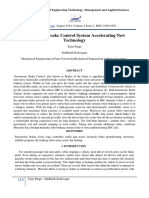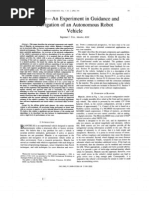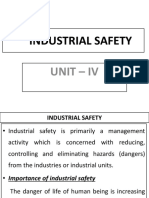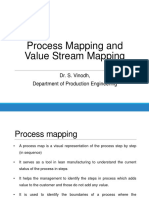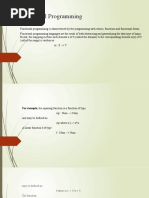Adaptive Cruise Control Using Model Predictive Controller
Adaptive Cruise Control Using Model Predictive Controller
Volume 6, Issue 6, June – 2021 International Journal of Innovative Science and Research Technology
ISSN No:-2456-2165
Adaptive Cruise Control using Model Predictive
Controller
B.Aniruth Narayanan
UG Student, Centre for Automation and Robotics, School of Mechanical Sciences,
Hindustan Institute of Technology and Science, Tamilnadu, India.
S. JANAKIRAMAN, Professor, ANRO(GUIDE)
Dr. D DINAKARAN, Head of Department, ANRO(CO-GUIDE)
Professor, Centre for Automation and Robotics, School of Mechanical Sciences,
Hindustan Institute of Technology and Science, Tamilnadu, India.
Abstract:- Adaptive cruise control system that is used in the lateral measuring accuracy of the camera, the adaptive
modern vehicles are highly helpful and very similar to cruise control (ACC) can detect a vehicle entering the
already existing cruise control system model.But the driver’s own lane much earlier, enabling the system to
difference between both is that ACC has the capabilities respond more dynamically. With the help of the radar, the
to supervise the environment and take decisions based system can correctly identify the lane in which the cars
on the constraints.A vehicle equipped with adaptive ahead are driving, thus enhancing the capabilities of the
cruise control system can monitor the exterior of the ego ACC, particularly when cornering. Thanks to sensor data
vehicle through an optical sensor and accelerate or fusion, the radar sensor system can include speed limits
decelerate accordingly.In case of absence of a preceding identified by the camera into the driving strategy. This
vehicle or an obstacle, the system guides the vehicle to increases the safety and reliability of the driver assistance
move at a constant set velocity.When the preceding system.
vehicle or the obstacle is inside the proximity range, then
the system switches from speed control to spacing
control.In spacing control, the acceleration and braking
systems both are overridden from manual mode and
when the proximity range has reached the threshold, the
algorithm calculates the appropriate speed for the
scenario and applies brakes in case it is necessary
I. INTRODUCTION
Adaptive cruise control is a feature that enables a
vehicle to make decisions based on the environment that it's
a part of. The system analyses the constraints and makes the
most optimized decision. There are two modes at which the
system works and are namely speed control and spacing
control. These control types will be analysed and studied in Fig 1.1 When a vehicle is in lead with ACC
further detail.
II. METHODOLOGY
The working methodology of an adaptive cruise
control is based on the constraints that it deals with. The
main two components used in the ACC system are front
radar sensor and multi purpose camera. The radar sensor and
multi purpose camera combination makes it possible to
implement further assistance and safety functions, such as
automatic emergency braking to prevent collision with
vehicles ahead and protect pedestrians. If the driver doesn’t
react in the event of an impending rear-end collision and
both sensor systems detect the critical object, the assistance
function will automatically intervene and trigger a full
emergency stop. Sensor data fusion can also significantly Fig 1.2 When vehicle change lane,ACC maintains set
enhance comfort and convenience. For instance, thanks to velocity.
IJISRT21JUN1079 www.ijisrt.com 1399
Volume 6, Issue 6, June – 2021 International Journal of Innovative Science and Research Technology
ISSN No:-2456-2165
Advantages of an ACC system V. PROGRAMMING
● As the driver is relaxed in the pilot seat, the ACC system
will safely be able to transport the passengers as well as disp('--- Model Predictive Control of a Basic Adaptive
the driver with ease. Cruise Control ---');
● Advanced technology such as an ACC system has no disp('Choose one of the options below');
room for human error.
disp('1. Basic ACC');
● It enables the user to have fuel efficient travel experience
and provides economic feasibility disp('2. ACC MPC and ACC LQR Comparison');
● ACC system drastically reduces the chances of rear end disp('3. MPC of ACC with varying prediction horizon N');
collisions and provides a smooth journey. disp('4. MPC of ACC with varying Q');
● It gives the driver some breathing space and helps disp('5. MPC of ACC with varying R');
him/her concentrate on the present traffic. disp('6. MPC of ACC with varying distance between cars');
● During cross country trips and journeys, ACC system disp('7. Stability analysis');
will be highly advantageous as the driver will also be
disp('0. Exit');
able to have quality recreation time.
pause(1);
Disadvantages of ACC system choice = input('Please choose --> ');
● ACC does not work below 25 mph (40 km/h). It cannot switch choice
bring your vehicle to a complete stop. case 1
● ACC may not recognize motorcycles or other small close all;
vehicles ahead of your vehicle. figure(1);
ACC_MPC_Final;
III. COMPONENTS OF ACC SYSTEM
disp('Do you want to run another simulation?');
Adaptive Cruise Control (ACC) consists of a radar opt = input('Enter your option [Y/any other key] --> ','s');
sensor in the front grille, the ACC buttons on the steering if opt == 'Y'
wheel, The radar sensor for ACC is shared with the braking main;
mechanism and acceleration mechanics. else
disp('Goodbye!');
ACC Module: This is a primary processing unit for which
the radar input is feeded into to determine if the forward end
vehicle is present. case 2
close all;
Engine Control Module: The primary function of the figure(2);
Engine Control Module is to receive information from the LQR_ACC;
ACC module and Instrument Cluster and control the disp('Do you want to run another simulation?');
vehicle's speed based on this information.
opt = input('Enter your option [Y/any other key] -->
Brake Control Module: This module is used to determine ','s');
if the braking is needed depending on the preceding vehicle. if opt == 'Y'
Instrument Cluster: The primary function of the Instrument main;
Cluster is to process the Cruise Switches and send their else
information to the ACC and Engine Control Modules. disp('Goodbye!');
end
IV. SOFTWARE
case 3
Matlab: close all;
Matlab is a proprietary multi-paradigm programming figure(3);
language and numerical computing environment developed ACC_MPC_varying_N;
by Matworks. The first Matlab was not a programming disp('Do you want to run another simulation?');
language, it was a simple interactive matrix calculated opt = input('Enter your option [Y/any other key] -->
,Matlab allows matrix manipulations ,plotting of functions
','s');
and data, implementation of algorithms, creation of user
interfaces, and interfacing with programs written in other if opt == 'Y'
languages. Although Matlab is intended primarily for main;
numerical computing, an optional toolbox uses the MuPAD else
Symbolic engine allowing access to symbolic computing disp('Goodbye!');
abilities. end
case 4
close all;
IJISRT21JUN1079 www.ijisrt.com 1400
Volume 6, Issue 6, June – 2021 International Journal of Innovative Science and Research Technology
ISSN No:-2456-2165
figure(4); VI. CONCLUSION
ACC_MPC_varying_Q;
disp('Do you want to run another simulation?'); Thus the Adaptive cruise control system using matlab
has been simulated and a brief study about the mechanical
opt = input('Enter your option [Y/any other key] -->
components and mechatronics system design aspects have
','s'); been looked into. Details related to adaptive cruise control
if opt == 'Y' system’s feasibility and economic aspects in our modern day
main; society have been studied in detail.
else
disp('Goodbye!'); REFERENCES
end
[1]. https://ieeexplore.ieee.org/document/8107024
case 5
[2]. https://www.bosch-mobility-
close all; solutions.com/en/products-and-services/passenger-
figure(5); cars-and-light-commercial-vehicles/driver-
ACC_MPC_varying_R; assistance-systems/automatic-emergency-
disp('Do you want to run another simulation?'); braking/sensor-data-fusion/
opt = input('Enter your option [Y/any other key] --> [3]. https://www.researchgate.net/publication/3427863_
','s'); Methodology_for_assessing_adaptive_cruise_contr
ol_behavior
if opt == 'Y'
[4]. https://www.mathworks.com/help/mpc/ug/adaptive
main; -cruise-control-using-model-predictive-
else controller.html
disp('Goodbye!'); [5]. https://www.mathworks.com/help/driving/ug/highw
end ay-lane-following.html?s_tid=srchtitle
case 6
close all;
figure(6);
ACC_MPC_init_dist;
disp('Do you want to run another simulation?');
opt = input('Enter your option [Y/any other key] -->
','s');
if opt == 'Y'
main;
else
disp('Goodbye!');
end
case 7
close all;
figure(7);
stability_analysis;
disp('Do you want to run a1nother simulation?');
opt = input('Enter your option [Y/any other key] -->
','s');
if opt == 'Y'
main;
else
disp('Goodbye!');
end
case 0
disp('Goodbye!');
otherwise
disp('Please input a valid number.');
pause(2);
main;
End
IJISRT21JUN1079 www.ijisrt.com 1401
You might also like
- Cruise Control Operation From Zero To Preset Speed-Simulation and ImplementationNo ratings yetCruise Control Operation From Zero To Preset Speed-Simulation and Implementation6 pages
- A Modular System Architecture For Sensor Data Processing of ADAS Applications100% (1)A Modular System Architecture For Sensor Data Processing of ADAS Applications6 pages
- Sensotronic Brake Control System Accelerating New TechNo ratings yetSensotronic Brake Control System Accelerating New Tech9 pages
- Complete Download Control Applications of Vehicle Dynamics 1st Edition Jingsheng Yu PDF All Chapters100% (13)Complete Download Control Applications of Vehicle Dynamics 1st Edition Jingsheng Yu PDF All Chapters70 pages
- Side View Assist (SVA) : Making Refined Cars For EveryoneNo ratings yetSide View Assist (SVA) : Making Refined Cars For Everyone21 pages
- White Paper On Hybrid Approach For ADAS Data Fusion Algorithm DevelopmentNo ratings yetWhite Paper On Hybrid Approach For ADAS Data Fusion Algorithm Development15 pages
- Canking - Can Simulation Software: EX. NO.1.B 02-07-2019No ratings yetCanking - Can Simulation Software: EX. NO.1.B 02-07-20196 pages
- Traction-Control-Oriented State Estimation For MotorcyclesNo ratings yetTraction-Control-Oriented State Estimation For Motorcycles8 pages
- Demonstration OF Braking SYSTEM of An EngineNo ratings yetDemonstration OF Braking SYSTEM of An Engine13 pages
- Design and Simulation of DC Motor Speed Controller Using Pole Placement Technique and MATLABNo ratings yetDesign and Simulation of DC Motor Speed Controller Using Pole Placement Technique and MATLAB9 pages
- User Manual - IS - CDC - 2 - Operations and Commands (Guia)No ratings yetUser Manual - IS - CDC - 2 - Operations and Commands (Guia)61 pages
- FILE - 20190313 - 100527 - Omni Directional Control Algorithm For Mecanum Wheel 24 Pages PDFNo ratings yetFILE - 20190313 - 100527 - Omni Directional Control Algorithm For Mecanum Wheel 24 Pages PDF24 pages
- Genetic Algorithms and Fuzzy Control 2003No ratings yetGenetic Algorithms and Fuzzy Control 200313 pages
- Immediate download Network Flow Algorithms 1st Edition Williamson ebooks 2024100% (2)Immediate download Network Flow Algorithms 1st Edition Williamson ebooks 202455 pages
- Blanche-An Experimental in Guidance and Navigation of An Autonomous Robot VehicleNo ratings yetBlanche-An Experimental in Guidance and Navigation of An Autonomous Robot Vehicle12 pages
- 2D Finite Element Model of The Audi E-Tron Induction Motor100% (1)2D Finite Element Model of The Audi E-Tron Induction Motor6 pages
- Multiobjective Optimization Package of Modefrontier: The State of The Art SurveyNo ratings yetMultiobjective Optimization Package of Modefrontier: The State of The Art Survey102 pages
- Control and Instrumentation Lab (AV 435)No ratings yetControl and Instrumentation Lab (AV 435)3 pages
- Epistemic Risks of Big Data Analytics in Scientific Discovery: Analysis of the Reliability and Biases of Inductive Reasoning in Large-Scale DatasetsNo ratings yetEpistemic Risks of Big Data Analytics in Scientific Discovery: Analysis of the Reliability and Biases of Inductive Reasoning in Large-Scale Datasets7 pages
- The Digital Influence ChatGPT and its Role in Shaping Youth Cognitive Processes and Decision-MakingNo ratings yetThe Digital Influence ChatGPT and its Role in Shaping Youth Cognitive Processes and Decision-Making5 pages
- To Compare the Effectiveness of Jacobson’s Relaxation Techniques and Mitchell’s Relaxation Techniques along with Diaphragmatic Breathing on Insomnia in Elderly IndividualsNo ratings yetTo Compare the Effectiveness of Jacobson’s Relaxation Techniques and Mitchell’s Relaxation Techniques along with Diaphragmatic Breathing on Insomnia in Elderly Individuals9 pages
- Influence of Age, Gender, Socioeconomic Status, and Education Level on Glycemic Control in Diabetic Patients Attending Kapkatet Sub-County Hospital, Kericho County, KenyaNo ratings yetInfluence of Age, Gender, Socioeconomic Status, and Education Level on Glycemic Control in Diabetic Patients Attending Kapkatet Sub-County Hospital, Kericho County, Kenya9 pages
- Bridging the Digital Divide in Agriculture: Lessons from the United States and Africa in Smart Farming AdoptionNo ratings yetBridging the Digital Divide in Agriculture: Lessons from the United States and Africa in Smart Farming Adoption10 pages
- A Comparative Analysis of Natural Language Processing Models: BERT and LSTM in Enhancing Business CommunicationNo ratings yetA Comparative Analysis of Natural Language Processing Models: BERT and LSTM in Enhancing Business Communication6 pages
- From Visualization to Purchase: How Augmented Reality (AR), Virtual Reality (VR) and Artificial Intelligence (AI) Influence Consumer Purchase Decisions in Housing Design DecisionsNo ratings yetFrom Visualization to Purchase: How Augmented Reality (AR), Virtual Reality (VR) and Artificial Intelligence (AI) Influence Consumer Purchase Decisions in Housing Design Decisions23 pages
- Case Study and Examination of Production Methods in a Steel Manufacturing FacilityNo ratings yetCase Study and Examination of Production Methods in a Steel Manufacturing Facility7 pages
- Impact of Storytelling and Emotional Branding on Consumer Purchase Behavior in Quick Service Restaurants and FMCGNo ratings yetImpact of Storytelling and Emotional Branding on Consumer Purchase Behavior in Quick Service Restaurants and FMCG15 pages
- Comparing the Effect of Ashoka Ointment and Herjet OintmentNo ratings yetComparing the Effect of Ashoka Ointment and Herjet Ointment5 pages
- AI-Driven Predictive Analytics for Syndromic Surveillance: Enhancing Early Detection of Emerging Infectious Diseases in the United StatesNo ratings yetAI-Driven Predictive Analytics for Syndromic Surveillance: Enhancing Early Detection of Emerging Infectious Diseases in the United States8 pages
- Geriatric Medication Management Using STOPP/START Criteria on Polypharmacy in a Multicentre Hospital: A Systematic ReviewNo ratings yetGeriatric Medication Management Using STOPP/START Criteria on Polypharmacy in a Multicentre Hospital: A Systematic Review6 pages
- Remarkable Spatial Influences behind Shaping the Bangla Dance: Performer and Audience PerspectivesNo ratings yetRemarkable Spatial Influences behind Shaping the Bangla Dance: Performer and Audience Perspectives8 pages
- Psychological Well-being among Tribal and Non-Tribal B.Ed. StudentsNo ratings yetPsychological Well-being among Tribal and Non-Tribal B.Ed. Students4 pages
- Affirmative Policy on Belis in Marriage Traditions at Family Institutions in the Abenaho District of PapuaNo ratings yetAffirmative Policy on Belis in Marriage Traditions at Family Institutions in the Abenaho District of Papua14 pages
- Synergizing Renewables with Power Grid: A Path towards Stability and SustainabilityNo ratings yetSynergizing Renewables with Power Grid: A Path towards Stability and Sustainability5 pages
- Library Personnel’s Career Development and Job Performance of the National UniversityNo ratings yetLibrary Personnel’s Career Development and Job Performance of the National University8 pages
- Autonomous Obstacle Avoiding and Pesticide Spraying Robot for Smart FarmingNo ratings yetAutonomous Obstacle Avoiding and Pesticide Spraying Robot for Smart Farming4 pages
- Factors Influencing the Organizational Performance of Hotel EstablishmentsNo ratings yetFactors Influencing the Organizational Performance of Hotel Establishments12 pages
- An Integrated Web Application for Campus Life: A Digital Solution for Learning and VotingNo ratings yetAn Integrated Web Application for Campus Life: A Digital Solution for Learning and Voting8 pages
- Structural Equation Modeling of Students’ Performance in Pre-Calculus: Basis for Intervention in Senior High School100% (1)Structural Equation Modeling of Students’ Performance in Pre-Calculus: Basis for Intervention in Senior High School12 pages
- Citizen Satisfaction with Electronic-Government Services: A Case Study of Huduma Centre MombasaNo ratings yetCitizen Satisfaction with Electronic-Government Services: A Case Study of Huduma Centre Mombasa13 pages
- Leveraging Digital Surveillance Technologies for Managing Border Porosity and Enhancing Revenue Collection in KenyaNo ratings yetLeveraging Digital Surveillance Technologies for Managing Border Porosity and Enhancing Revenue Collection in Kenya11 pages
- Leveraging Wi-Fi-Based Tracking for Enhanced Conference Management and Exhibitor ValueNo ratings yetLeveraging Wi-Fi-Based Tracking for Enhanced Conference Management and Exhibitor Value11 pages
- Precision, Prediction and Progress: A New Era in PharmacologyNo ratings yetPrecision, Prediction and Progress: A New Era in Pharmacology23 pages
- Contracts For The Benefit of Third PartiesNo ratings yetContracts For The Benefit of Third Parties16 pages
- The Common Temple Ideology of The Ancient Near EastNo ratings yetThe Common Temple Ideology of The Ancient Near East22 pages
- Complaint To The EU Regarding The Sea Diamond WreckNo ratings yetComplaint To The EU Regarding The Sea Diamond Wreck14 pages
- Addition & Subtraction To The Hundred ThousandsNo ratings yetAddition & Subtraction To The Hundred Thousands11 pages
- Process Mapping and Value Stream MappingNo ratings yetProcess Mapping and Value Stream Mapping24 pages
- Leading the Way in Financial Excellence: M&M AL MENHALI AUDITING, Dubai's Top Accounting FirmNo ratings yetLeading the Way in Financial Excellence: M&M AL MENHALI AUDITING, Dubai's Top Accounting Firm7 pages










